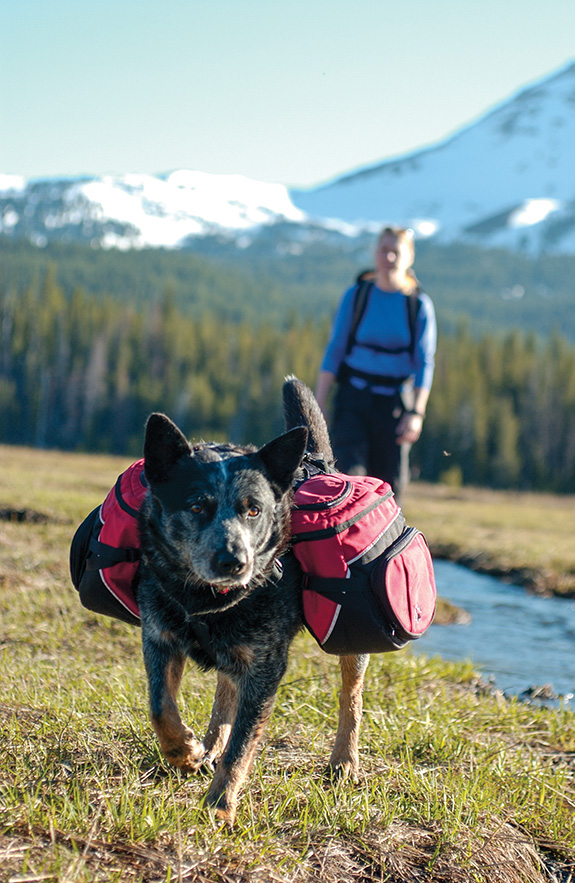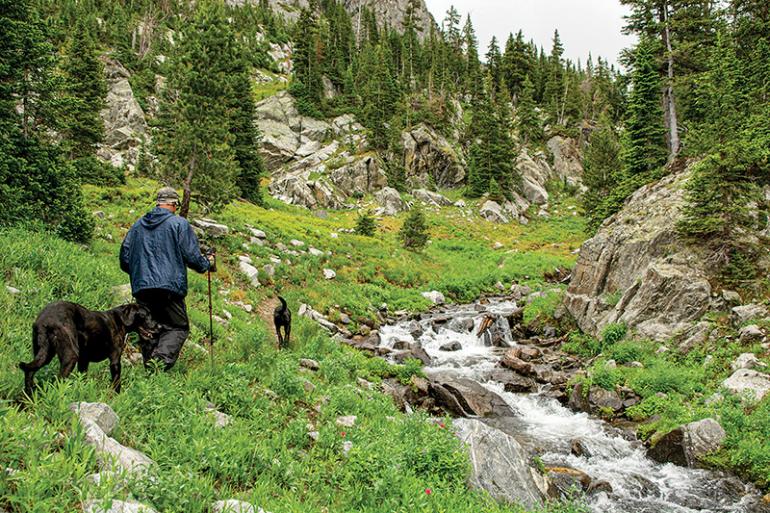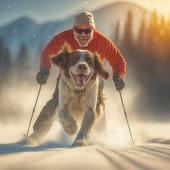Trail Tails
Tips and guidelines for hiking with a dog.
With spring comes more opportunity to comfortably and safely get outdoors for some fun with your dog. It’s a perfect time to start planning trips and organizing equipment, and to get both yourself and your dog into shape for those long summer hikes and camping trips.
A visit to the vet will help make sure there are no underlying conditions such as arthritis or heart disease, which could prevent safe trips into the wilderness. Like humans, dogs need to be conditioned properly in advance of strenuous hikes. This not only involves building muscle tone and stamina over time, but also helps toughen a dog’s feet for the trails. Some dogs naturally have tougher paw pads, but some may benefit from wearing booties on rough, rocky terrain—and booties take some getting used to. A veterinarian can also advise you on appropriate vaccinations for the areas you visit, flea/tick preventatives for wilderness activities, and how to pack and use a dog first-aid kit.
Always work with your dog so that he or she is a good citizen when on the trails. Lucy should remain well-behaved and walk well on a leash, and should not be allowed to run free in areas with leash laws or a high population of hikers. Even if your dog is well-behaved and comes when called, some dogs you meet on the trail can be fearful of, or aggressive toward, other dogs. Even some humans get scared of dogs running up or barking at them. Your dog should sit calmly and quietly by your side when horses, llamas, other dogs, and other people pass, and your dog should never be allowed to chase wildlife.
When hiking or camping, a mature adult dog may be able to carry a well-fitted, snug (but not too tight) backpack. Bridger will need to be trained and conditioned to carry the pack, and should not be asked to carry more than 10-12% of his body weight. This is a general rule, unless the dog is bred to carry weight; even then, conditioning is imperative. As with humans, carrying too much weight or carrying light loads when unconditioned can cause a number of injuries, many of which may result in long-term orthopedic conditions or spinal damage.

Most folks who pack with dogs only ask them to carry their own food and maybe some water. Remember that it often makes more sense to bring a water filter (dogs can get diseases from drinking unfiltered lake or creek water, too!) and a container to drink from. The average dog drinks between 0.5 and 1.5 ounces per pound of bodyweight per day, sometimes more when it’s particularly hot or strenuous. Dogs may also need more food when on long hikes or during multi-day trips involving a lot of exercise. A general rule of thumb for strenuous exercise is to increase the dog’s total normal daily food intake by about one cup per 20 pounds of bodyweight per day. Remember to take frequent breaks during long hikes, and to snack and drink water. Monitor Bridger closely to see whether or not his heart and respiratory rate normalize relatively quickly during rest, ideally in the shade. If not, you should cut your trip short.
When camping, make sure to have adequate space in the tent and a sleeping pad for your canine friend. Remember as well that dog nails can poke holes in tent materials, so ensure that Madison’s nails are short and well-filed, or have her wear booties when in the tent. If it’s her first trip, it’s wise to try a dry-run in the tent. A restless dog or one who awakens and barks at every strange noise in the forest can ruin an otherwise peaceful night of sleep.
One last thing: NEVER leave dog poop along the trail, loose or bagged up. People go hiking to enjoy nature and the beautiful scenery. They should not have to dodge piles of excrement or look at knotted-up little baggies along the trail. When getting a dog, you take on the responsibility of being a good ambassador for dog-owners everywhere—always pack out the poop! You can double-bag it to prevent leakage, and when out in the wilderness, you can also bury it just like one would human waste—in a hole, six to eight inches deep, at least 200 feet from campsites, water, and trails. Remember that having your dog along for the ride is a privilege, not a right, one that could be taken away from all of us if we do not leave things as clean, or cleaner, than we found them.
Julie Oghigian is a Bozeman veterinarian, veterinary columnist, and outdoor enthusiast.











